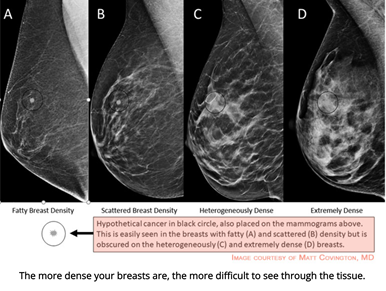Breast Density: A Starter Guide
What is Breast Density?
Dense breasts contain more glandular tissue and less fat tissue. The NHS explain that having dense breasts is normal and isn't something that you can change. Dense breasts are not the same as having firm breasts and has no relation to the feel, shape and size of your breasts.
Breast tissue is typically classified into four categories according to the Breast Imaging Reporting and Data System (BI-RADS). These are classified as A, B, C & D, as shown in the image courtesy of My Density Matters. Category A are breasts that contain mostly fatty breast tissue. D refers to breasts that contain mostly dense Tissue. This dense tissue can obscure cancer on a mammogram, as it is more difficult for them to penetrate this dense tissue.
Who has Dense Breasts?
It is common for young women who haven't gone through the menopause to have dense breasts. Breast tissue often starts to become less dense as you get older, usually after menopause. However, 50% of women at screening age still have dense breasts.
How can you find out your breast density?
Breast Density is identified from a mammogram, and is typically identified by the radiologist recording the amount of fatty tissue they can see in comparison to breast tissue. It can also be measured using special software to extrapolate this information from the mammogram. There are no requirements in the UK or the EU for clinicians to inform you of your breast density. This information will be in your mammogram and you are entitled to ask for this information. In the US it is now mandatory for women to be informed of their breast density category and the implications this could have for breast screening.
Dense Tissue & Breast Cancer Risk
Breast density is an independent risk factor for breast cancer. Studies have shown women with dense breasts to be 2-4 times more likely to develop breast cancer than women with fatty breasts.
Breast Density & Screening
Mammography remains the standard screening test for breast cancer and is proven to reduce deaths due to breast cancer. However, dense breasts can make breast cancer screening more challenging because the dense tissue can mask potential tumours on a mammogram. These tumours may not be discovered until they have grown and possibly spread.
Screening tests including MRI and ultrasound may be used to supplement mammography, this subsequently increases detection of breast cancer in women with dense breasts. Whether this is offered as part of screening will vary depending on your risk factors and the screening regime used in your country or state.
Micrima & Breast Density
Micrima has developed a handheld device that measures breast tissue properties and provides a BI-RADS breast density score in one minute. Having a pre-scan with the Mi~Scan device means the best imaging technique for a woman’s tissue type can be selected first time. The density output can also be used for risk profiling in all women from a younger age, to identify high-risk women who could benefit from early screening.
If you discover any symptoms of Breast Cancer, seek help from a medical professional and always go for your mammogram when invited by your healthcare provider. If you want to learn more about breast cancer and density, visit My Density Matters.
To keep up to date with our developments, please follow us on socials.
@micrimalimited














